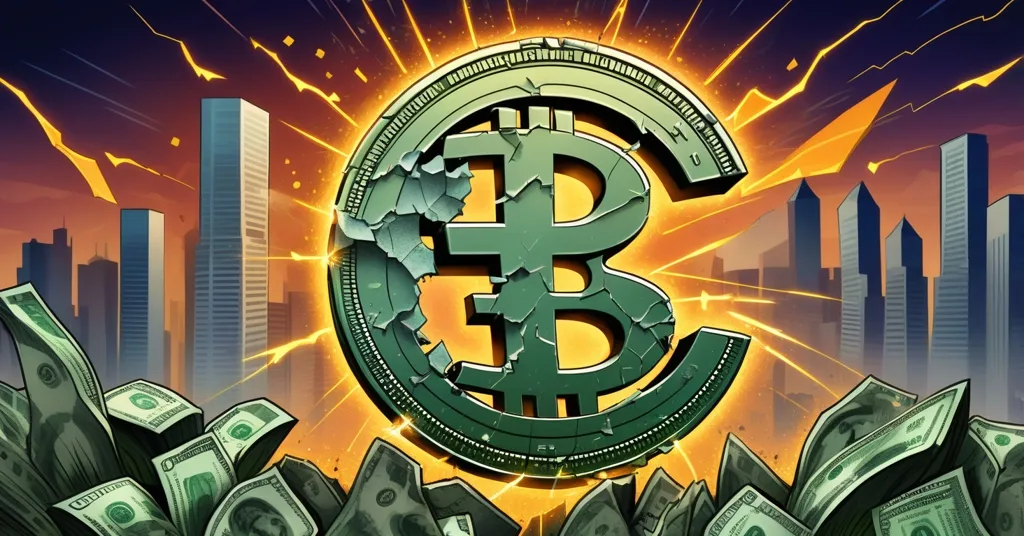Trump’s 2025 Trade Policies Tank US Dollar, Boost Bitcoin as Fiat Hedge

Trump’s Trade Policies 2025: US Dollar Slump Fuels Bitcoin Opportunity
President Trump’s aggressive trade policies have sent global markets into a tailspin, with the Euro skyrocketing over 14% against the US dollar since the start of 2025. As tariffs, fiscal recklessness, and attacks on institutional independence shatter confidence in the greenback, investors are scrambling for safer ground—some even eyeing Bitcoin and decentralized technologies as a way out of the fiat mess.
- Euro Surge: Up 14% against the dollar in 2025 due to US economic missteps.
- Dollar Drop: Reserve share falls from 68.8% in 2014 to 57.8% by 2024, with more declines looming.
- Crypto Opening: Fiat instability could drive adoption of Bitcoin as a hedge against currency chaos.
US Dollar Decline: A Self-Inflicted Wound
The US dollar, once the unshakable pillar of global finance, is crumbling under the weight of its own government’s decisions. Since early 2025, a toxic mix of new tariffs, a massive tax-and-spend bill, and direct interference with the Federal Reserve’s independence under Trump’s administration has severely damaged investor confidence. The hard numbers paint a grim picture: the dollar’s share of foreign currency reserves—basically, the portion of global wealth held in dollars for trade and stability—has plummeted from 68.8% in 2014 to just 57.8% by the end of 2024. Analysts expect this downward spiral to continue through 2025 as foreign investors grow wary of US economic stability.
Central bankers aren’t mincing words about this disaster. At a conference in France, Yannis Stournaras, Governor of Greece’s Central Bank, pinpointed the root causes of the dollar’s freefall with surgical precision.
“If you combine [US] tariffs with the attacks on the Fed and institutions, with the fiscal sustainability of the United States following the ‘beautiful’ tax bill, it explains the evolution of the dollar exchange rate in the recent weeks,” Stournaras said.
He didn’t stop at diagnosis, offering a stark warning to tariff enthusiasts: “Those who impose tariffs will be hurt first.” His point cuts deep—Trump’s protectionist moves, including pricier trade deals with the UK and Vietnam compared to earlier this year, aren’t strengthening the US economy as promised. They’re ballooning the national deficit and repelling foreign capital. It’s almost as if slapping tariffs and trade policies and printing money is a masterclass in how to tank your own currency.
Gabriel Makhlouf, Head of Ireland’s Central Bank, added another layer of concern, pointing to a broader erosion of trust in American governance. “They’re seeing the rule of law in the United States actually weaken, and they are responding accordingly, because that means there’s a greater risk to their investments and their assets, and they’re adjusting,” he observed. This isn’t just about balance sheets; it’s a credibility crisis. Deutsche Bank analysts George Saravelos and Christian Wietoska summed up the sentiment with brutal clarity: foreigners aren’t dumping US assets—they’re just saying “no thanks” to buying more. That quiet rejection is louder than any sell-off.
Euro’s Rise: A Safe Haven or Just Less Risky?
Across the Atlantic, the Euro is basking in a glow it hasn’t earned. Despite the European Central Bank (ECB) slashing interest rates recently—a move that should weaken a currency—the Euro has surged, purely because the US looks like a far riskier bet. Its share of international reserves has hovered around 20% for over a decade, but now there’s talk of it gaining ground as the dollar stumbles. Paschal Donohoe, President of the Eurogroup, stressed the need for solidity, stating, “The key thing for us is how we can have strong foundations in place for the Euro’s potential as a reserve currency.”
Part of that foundation involves ambitious EU projects like the Banking Union and Capital Markets Union, aimed at knitting together Europe’s patchwork financial systems. Then there’s the NextGenerationEU plan, a post-COVID recovery push set to ramp up Euro-denominated borrowing in the coming years. If successful, these could position the Euro as a bigger player in global reserves, especially with ongoing EU financial integration efforts. But let’s not kid ourselves—Europe isn’t exactly a bastion of economic vigor. Low growth, political fragmentation, and lingering debt issues mean the Euro’s “safe haven” status is more about the dollar’s self-destruction than any European triumph. It’s like picking the least leaky boat in a storm; neither’s ideal, but one might keep you afloat a bit longer.
Bitcoin’s Moment: Decentralization in a Fiat Crisis
For those of us tuned into the crypto space, this fiat fiasco is less a tragedy and more a neon sign flashing “opportunity.” When a currency as dominant as the dollar starts wobbling—thanks to political meddling and fiscal irresponsibility—it’s a stark reminder of why Bitcoin serves as a hedge against fiat instability. Think of the dollar as a once-trusted bank losing depositors’ faith due to shady management, while Bitcoin is the secure, independent vault no one can tamper with. Its core promise—a peer-to-peer, censorship-resistant currency immune to central bank whims or government overreach—shines brightest when traditional systems falter.
History backs this up. During fiat crises in places like Venezuela and Zimbabwe, Bitcoin’s price and adoption spiked as people sought refuge from hyperinflation and capital controls. Even today, on-chain data shows wallet creation and transaction volumes often surge during geopolitical unrest or currency devaluation. Sure, Bitcoin isn’t without flaws—its price swings can make your stomach churn faster than a memecoin rug pull—but over the long haul, its narrative as a store of value holds strong against inflating fiat, as seen in Bitcoin’s behavior during dollar volatility. When trust in the world’s reserve currency erodes, a decentralized alternative starts looking less like a gamble and more like a lifeline.
Trump’s trade tantrums might just be the unintended marketing campaign Bitcoin never asked for. As the dollar bleeds value and the Euro limps forward on shaky legs, the idea of financial sovereignty—owning your wealth without a middleman who can devalue it overnight—gains traction. This isn’t just about investors; everyday folks and small businesses feeling the pinch of currency swings are starting to peek at crypto too. Picture a small European exporter, battered by dollar volatility in trade deals, quietly hedging with Bitcoin to protect their margins. That’s the kind of real-world shift we’re seeing seeds of now, supported by expert views on Bitcoin adoption trends.
Broader Crypto and Blockchain Implications
Bitcoin might be the poster child for decentralization, but it’s not the only player poised to benefit from this mess. Altcoins and decentralized finance (DeFi) protocols—built on networks like Ethereum—fill niches Bitcoin doesn’t touch. DeFi, for instance, offers lending and borrowing platforms without banks, a tempting alternative as trust in traditional finance wanes. Imagine bypassing a creaky banking system altogether, earning yield on your assets via smart contracts while fiat currencies duke it out. These systems aren’t perfect—security risks and regulatory uncertainty loom large—but they’re proof of concept that blockchain tech can disrupt broken financial models.
That said, as Bitcoin maximalists at heart, we’d argue the king still reigns supreme in a crisis. Its unmatched security, network effect, and first-mover status make it the ultimate store of value when fiat fails. Altcoins and DeFi have their place, carving out innovative use cases, but nothing matches Bitcoin’s battle-tested resilience as a hedge against centralized chaos. This fiat turmoil, exacerbated by Trump’s trade policies impacting the dollar, could also push institutional players, spooked by dollar instability, toward digital assets—if not for speculation, then for diversification. On the flip side, a weakened dollar might spook US policymakers into cracking down on crypto, seeing it as a threat to national financial control. That regulatory risk is real and worth watching.
From an effective accelerationist lens, this crisis is a catalyst. Fiat failures speed up the inevitable shift to decentralized systems, proving that centralized power is often a liability. Every tariff, every attack on the Fed, every bloated deficit dollar is a nudge for more people to wake up to blockchain’s potential. We’re not just reporting news here; we’re witnessing the cracks in the old guard that could fast-track a financial revolution, especially when considering community discussions on how tariffs affect the dollar’s global standing.
Key Takeaways and Questions for Reflection
- How are Trump’s trade policies undermining the US dollar?
Through steep tariffs, interference with the Federal Reserve, and a reckless tax-and-spend bill, these policies are eroding investor confidence, causing a significant drop in the dollar’s value against the Euro. - Why is the Euro seen as a safer option despite its weaknesses?
The Euro’s appeal comes from the US appearing far riskier due to economic mismanagement and a perceived decline in rule of law, making it a relative safe haven even with ECB rate cuts and EU structural issues. - What does fiat currency volatility mean for Bitcoin adoption?
With declining trust in fiat like the dollar, Bitcoin stands out as a decentralized hedge against instability, potentially driving more individuals and institutions to adopt it for financial protection. - Can the Euro truly become a dominant global reserve currency?
While it could grow beyond its 20% reserve share, this depends on the EU overcoming internal challenges and completing integrations like the Banking Union, amidst ongoing economic struggles. - How can blockchain and other cryptos benefit from this financial unrest?
Beyond Bitcoin, DeFi and altcoins on platforms like Ethereum offer alternatives to traditional finance, providing solutions like decentralized lending that could gain traction as fiat systems falter.



